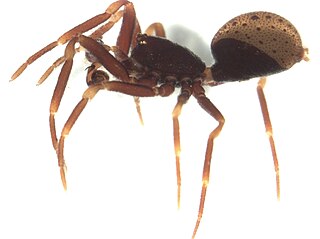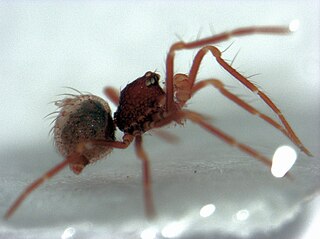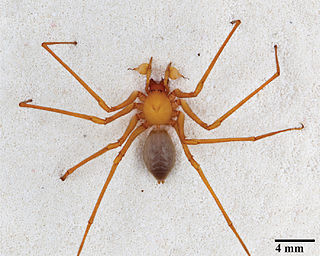
The family Dipluridae, known as curtain-web spiders are a group of spiders in the infraorder Mygalomorphae, that have two pairs of booklungs, and chelicerae (fangs) that move up and down in a stabbing motion. A number of genera, including that of the Sydney funnel-web spider (Atrax), used to be classified in this family but have now been moved to Hexathelidae.

Atracidae is a family of mygalomorph spiders, commonly known as Australian funnel-web spiders or atracids. It has been included as a subfamily of the Hexathelidae, but is now recognized as a separate family. All members of the family are native to Australia. Atracidae consists of three genera: Atrax, Hadronyche, and Illawarra, comprising 35 species. Some members of the family produce venom that is dangerous to humans, and bites by spiders of six of the species have caused severe injuries to victims. The bite of the Sydney funnel-web spider and northern tree-dwelling funnel-web spider are potentially deadly, but no fatalities have occurred since the introduction of modern first-aid techniques and antivenom.

Latrodectus is a broadly distributed genus of spiders with several species that, together, are referred to as true widows. This group is composed of those often loosely called black widow spiders, brown widow spiders, and similar spiders. However, such general "common names" are of limited use as the diversity of species is much greater. A member of the family Theridiidae, this genus contains 32 species, which include several North American "black widows". In addition to these in North America are also the red widow Latrodectus bishopi and the brown widow Latrodectus geometricus, which, in addition to North America, has a much wider geographic distribution. Elsewhere, others include the European black widow, the Australian redback black widow, several different species in Southern Africa that can be called Button spiders, and the South American black widow spiders. Species vary widely in size. In most cases, the females are dark-coloured, but some may have lighter bodies or even reddish. Many can have red, white or brown markings on the upper-side (dorsal) of the abdomen. Some can be readily identifiable by reddish markings on the central underside (ventral) abdomen, which are often hourglass-shaped.

Theridiidae, also known as the tangle-web spiders, cobweb spiders and comb-footed spiders, is a large family of araneomorph spiders first described by Carl Jakob Sundevall in 1833. This diverse, globally distributed family includes over 3,000 species in 124 genera, and is the most common arthropod found in human dwellings throughout the world.

Hexathelidae is a family of mygalomorph spiders. It is one of a number of families and genera of spiders known as funnel-web spiders. In 2018, the family was substantially reduced in size by genera being moved to three separate families: Atracidae, Macrothelidae and Porrhothelidae. Atracidae includes the most venomous species formerly placed in Hexathelidae.

Barychelidae, also known as brushed trapdoor spiders, is a spider family with about 300 species in 42 genera. Most spiders in this family build trapdoor burrows. For example, the 20 millimetres (0.79 in) long Sipalolasma builds its burrow in rotted wood, with a hinged trapdoor at each end. The 10 millimetres (0.39 in) long Idioctis builds its burrow approximately 5 centimetres (2.0 in) deep, just below the high tide level, sealing the opening with a thin trapdoor.

Austrochilidae is a small spider family with ten species in three genera. Austrochilus and Thaida are endemic to the Andean forest of central and southern Chile and adjacent Argentina, while Hickmania is endemic to Tasmania. The monophyly of the family and the relationships among the genera are uncertain as of May 2017.

Gradungulidae, also known as large-clawed spiders, is a spider family endemic to Australia and New Zealand. They are medium to large-sized haplogyne spiders with three claws and two pairs of book-lungs similar to Mygalomorphae. Some species build extensive webs with an upper retreat tangle and connecting threads to scaffolding. This supports the ladder-like catching platform that is glued to the ground. Progradungula, a large spider with long legs like Hickmania, and Macrogradungula are the only cribellate genera of the family.

Periegops is a genus of spiders with six eyes instead of the usual eight. It is the only genus in its family (Periegopidae) and has three described species. It was long considered to be members of Sicariidae or Segestriidae until Raymond Forster elevated them to the family level in 1995.

Orsolobidae is a six-eyed spider family with about 180 described species in thirty genera. It was first described by J. A. L. Cooke in 1965, and was raised to family status from "Dysderidae" in 1985.

Malkaridae is a small family of araneomorph spiders first described by V. T. Davies in 1980. In 2017, the family Pararchaeidae was brought into synonymy with Malkaridae.

The Micropholcommatinae are a subfamily of araneomorph spiders in the family Anapidae. They were previously treated as the family Micropholcommatidae. Micropholcommatins are extremely small, with body lengths typically between 0.5 and 2 mm. They are usually found among leaf litter or moss.
Idiosoma is a genus of Australian armored trapdoor spiders that was first described by Anton Ausserer in 1871. Originally placed with the Ctenizidae, it was moved to the armored trapdoor spiders in 1985. The name is derived from the Greek ἴδιος (idios), meaning "individual, unique", and σῶμα (soma), meaning "body", referring to the distinctive structure of the abdomen.

Progradungula is a genus of Australian large-clawed spiders that was first described by Raymond Robert Forster & Michael R. Gray in 1979. As of May 2019 it contains only two species: P. carraiensis and P. otwayensis.

Sason is a genus of bark-dwelling brushed trapdoor spiders first described by Eugène Simon in 1887. It is distributed from the Seychelles through India to northern Australia. The closest related genus seems to be the monotypic Paracenobiopelma.

Spiders are air-breathing arthropods that have eight legs, chelicerae with fangs generally able to inject venom, and spinnerets that extrude silk. They are the largest order of arachnids and rank seventh in total species diversity among all orders of organisms. Spiders are found worldwide on every continent except for Antarctica, and have become established in nearly every habitat with the exceptions of air and sea colonization. As of July 2019, at least 48,200 spider species, and 120 families have been recorded by taxonomists. However, there has been dissension within the scientific community as to how all these families should be classified, as evidenced by the over 20 different classifications that have been proposed since 1900.

Trogloraptor is a genus of large spiders found in the caves of southwestern Oregon. It is the sole genus in the family Trogloraptoridae, and includes only one species, Trogloraptor marchingtoni. These spiders are predominantly yellow-brown in color with a maximum leg span of 3 in (7.6 cm). They are remarkable for having hook-like claws on the raptorial last segments of their legs.
Pinkfloydia is a genus of small Australian long-jawed orb-weavers, reaching a maximum lengths of about 4.5 millimetres (0.18 in). It was first described by D. Dimitrov & G. Hormiga in 2011, and contains two species, found in New South Wales and Western Australia: P. harveyi and P. rixi. They have a unique rounded, cone-shaped head structure with one pair of large eyes and three pairs of smaller eyes. The genus is named after British rock band Pink Floyd.
Perissopmeros is a genus of spiders in the family Malkaridae. It was first described in 1932 by Butler. As of 2017, it contains 7 species, all from Australia.














